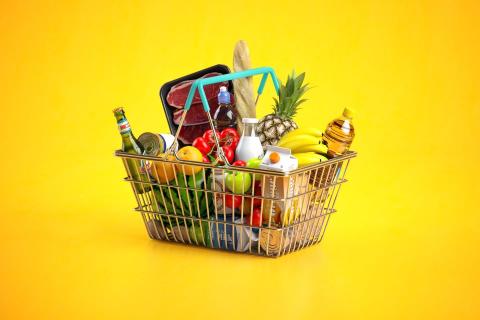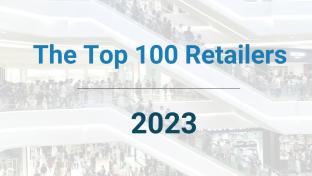Top 10 Grocery Retailers of 2023

The grocery segment is one of the areas most ripe for innovation within retail. Therefore, there’s been a lot of technological transformation and innovative strategies put forth over the last several years. But who leads the pack and why?
For the sixth consecutive year, RIS has collaborated with wRatings to rank the industry’s top performing retailers. We’ve highlighted the top 100 companies that are continuing to prosper despite the ongoing volatility, analyzing their percentage of market share and how it translates to overall sales and where these companies are investing to maintain their competitive edge. The Top 10 alone totals $2.4 trillion in sales — besting last year’s $2.3 trillion.
Below RIS breaks out the Top 10 grocery retailers from the full Top 100 list.
We chose to keep supercenters like Target and Walmart on the list, while keeping convenience stores off in order to get a cleaner picture of true grocers in the space — those that not only provide packaged goods, but also offer fresh produce as well.
While Amazon has significantly pulled back from its grocery efforts this year, it continues to have a strong brick-and-mortar grocery presence within its Whole Foods segment, which it says it will continue to invest in. Therefore, we have decided to keep it within the list below.
1. Walmart

Walmart claimed the No.1 spot overall within our main Top 100 Retailers list with a 16.98% retail share of the market, equating to $611 billion in sales. It also comes in at the top spot of the grocery segment.
The company wavered in its share of the market in the last few years, but for 2023 it has bounced back, increasing its market share by 4.31% YoY, continuing to beat out Amazon for the lead spot.
In recent months, Walmart store closings have permeated the news cycle; however, this is just a small piece of context of the brand’s larger story: refining its business operations by trimming the fat and investing heavily in digital transformation.
2. Amazon

Amazon ranked second on our overall list as well as the grocery ranking. The company makes up a 14.28% share of the retail market, totaling nearly $514 billion in sales. This is a significant bump compared to last year, resulting in an almost $45 million difference in sales from when the company claimed 10.40% of the market in 2022.
Amazon has been pausing its brick-and-mortar supermarket expansion — with plans to close some Amazon Fresh and Amazon Go physical locations — to refine the plan and meet changing demands.
“We're continuously refining our store formats to find the ones that will resonate with customers, will build our grocery brand, and will allow us to scale meaningfully over time,” said CFO Brian Olsavsky in a statement. This shift followed a flurry of job cuts and Amazon Prime benefit limitations.
The grocery segment hasn’t been completely forgotten, however. Amazon continues to fortify its Whole Foods strategy, recently announcing plans to install Amazon One contactless checkout payment at 11 Colorado locations.
3. Costco
Costco ranked No. 4 in the overall retail ranking and third in grocery. It owns 6.51% of the market, totaling $234 billion in sales. This is up slightly from last year’s $210 billion in sales.
Costco was recognized several times over the past year, most recently as a top five Most Trustworthy Retailer by Newsweek and Statista. In February of this year, Costco also ranked No. 2 as a top U.S. grocery retailer on the dunnhumby Retailer Preference Index. The company was recognized for its dependability and saving customers money while delivering a seamless experience.
4. Kroger

Kroger ranked No. 6 in the overall list, but made it to the Top 5 of the grocery ranking. The company has managed several significant enterprise-wide investments over the past year, including a heavy workforce wellbeing lift and a middle-mile transportation overhaul, celebrating $148 billion in sales and a 4.12% share of the market.
Additionally, for the fourth consecutive year, the company’s retail media arm, Kroger Precision Marketing (KPM) — powered by 84.51° — recently received a platinum certification from the Trustworthy Accountability Group (TAG). The certification recognizes brands and tech providers who are fighting criminal activity and protecting brand safety across digital advertising.
5. Target
Target ranked No. 8 in the overall retail ranking, but just cracked the Top 5 of the grocery list. Making up 3.03% of the retail market, totalling $109 billion in sales, the company has made several strides over the past year. For example, it recently launched nationwide drive-up returns and is planning for several enterprise-wide upgrades.
Target says it plans to invest $4 billion to $5 billion this year to expand its guest-centric services, operations network of stores and supply chain facilities, digital experiences, and other capabilities like enterprise efficiency.
Can’t Get Enough of Grocery? Learn About GroceryTech
The first annual GroceryTech event brings together the combined Progressive Grocer and RIS News community of business and technology grocery execs who are on the journey to modernize their tech infrastructure to support innovation.
Learn more and register.
The remainder of the Top 10 list is made up of Albertsons, George Weston (Loblaw), Empire Company, BJs Wholesale Club, and SpartanNash.
We recently featured Frank Vasi, tax manager at Albertsons in a RIS webinar that outlined common sources of friction in the retail experience. The company ranked No. 6 on the grocery ranking, making up 2.13% of the overall retail market share.
George Weston, one of Canada's largest supermarket retailers, came in seventh with a 1.55% share of the retail market. Its retail brands include President's Choice, No Name, and Joe Fresh.
Ranked eighth is Empire Company with a 0.86% share of the retail market. The Canadian-based company includes several well-known grocery brands, including Safeway, IGA, FreshCo, Sobeys, and more.
In the No. 9 spot among its grocery competitors is BJs Wholesale Club. BJs, which makes up a 0.54% share of the overall retail market, recently invested in an artificial intelligence-powered inventory robot that will increase its visibility into chainwide operations and club conditions.
And rounding out the Top 10 Grocery Retailers list is SpartanNash, which makes up 0.27% of the retail market and has recently made several leadership changes to bolster its executive team. It named Arpen Shah its vice president of merchandising strategy and analytics and promoted David Sisk to executive vice president, chief customer officer.
Methodology
While other lists rank retailers on total revenue, profit, or even share price, this annual list takes a different approach. The retailers that make our Top 100 are ranked on their piece of the total retail market.
Our rankings are based on data gathered from research partner Gary A. Williams, CEO of wRatings. The financial metrics of 180 publicly traded retailers were examined.
The economic data is from a trailing 12-month period ending on March 24, 2023. The percent of retail market share was calculated against a total retail market of around $3.6 trillion. The research ranked North American (including U.S., Canada, Bermuda, Virgin Islands) retailers across apparel, department store, grocery, furniture, beauty, building supply, convenience/fuel, e-commerce, hardlines, and softlines segments.
When comparing this year’s list to last year, we’ve implemented a few changes, which impacted overall rankings when comparing year-over-year. For this year’s rankings, we’ve pulled out all the retailers that were not North America-based. This move eliminated a total of five retailers from the 2023 list, including two which normally make the Top 10: JD.com and Alibaba Group. The five retailers eliminated included four from China and one from Japan because, while these companies all trade on a U.S.-based stock exchange, they don’t operate stores in the country.
Additionally, we deleted the restaurant chains category. These changes did not impact the top five retailers on this year’s list, but the removal of JD.com and Alibaba Group left room for home improvement retailer Lowe’s and convenience retailer Alimentation Couche-Tard to step up to the limelight, notching the No. 9 and No. 10 spots of the top 10 retailers. Click here for the full “Top 100 Retailers in 2023” list.



